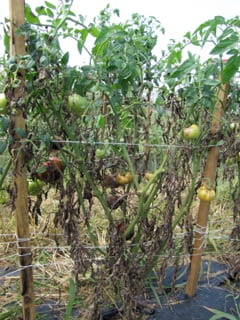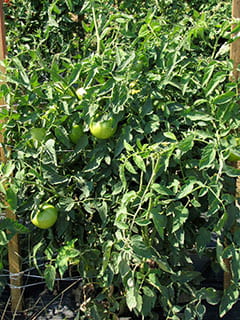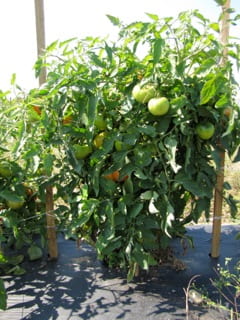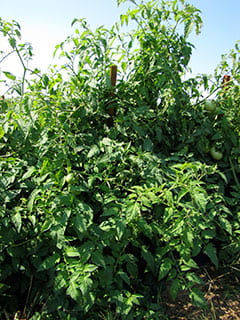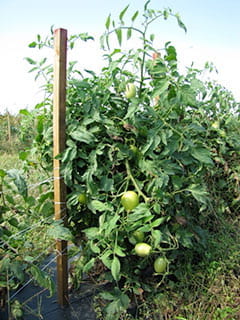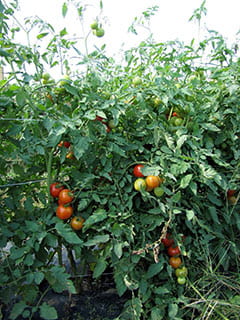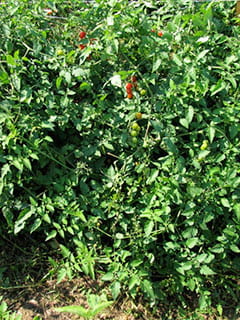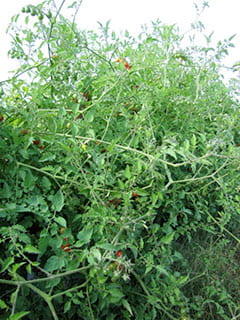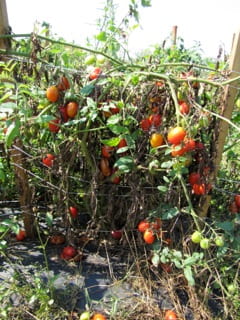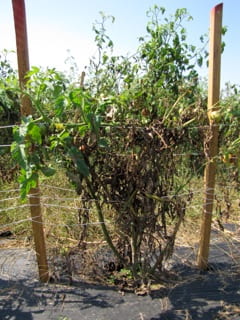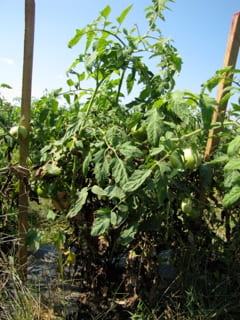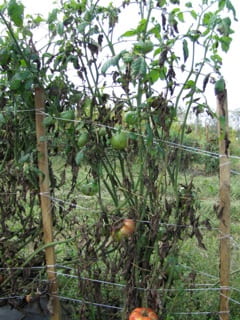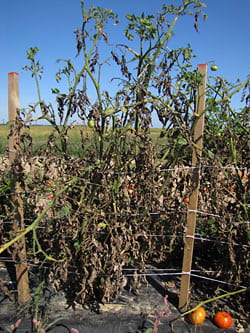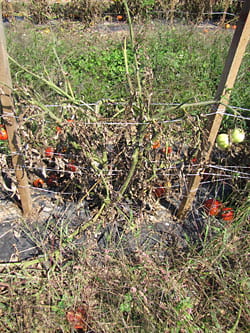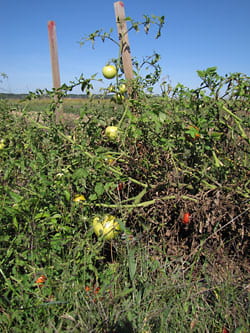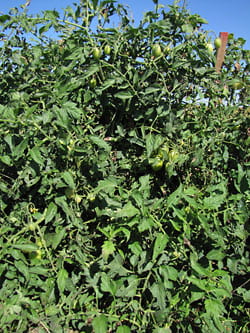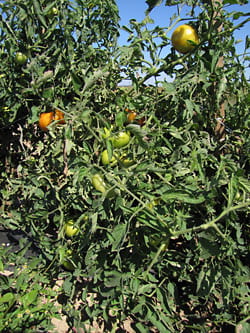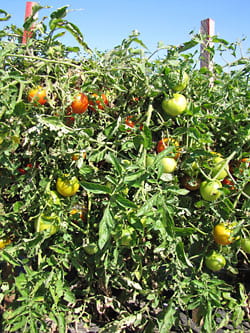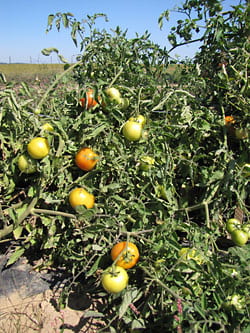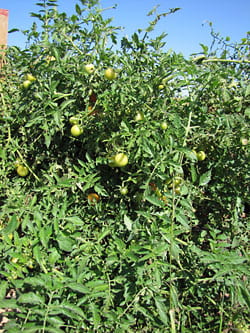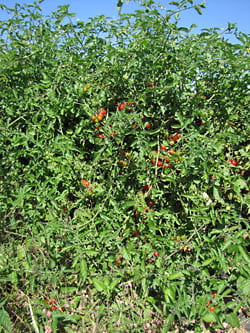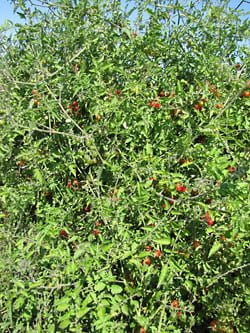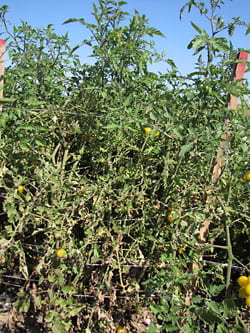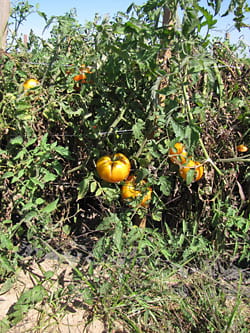Related information:
- Technical reports on these and related experiments have been published.
- Find more resistant tomato varieties released since these studies in the disease-resistant tomato variety lists. Those with same resistance genes as varieties evaluated in this study can be expected to exhibit similar ability to resist late blight.
- Additional information about late blight and its management plus photographs.
- Maps of late blight reports by county in U.S. since 2011.
Before 2009, late blight occurrence on Long Island, N.Y., was sporadic with symptoms never found or not seen until October in most years. Starting in 2009, the disease began occurring routinely in the northeastern USA, starting early in the growing season and severely impacting tomatoes. From 2009 to 2012 on Long Island, symptoms were first observed in late May to mid June.
Changes in occurrence of late blight was at least partly due to the fact there were new genotypes (strains) of the pathogen in the USA. Many were more aggressive on tomato and more tolerant of warm temperatures than genotypes like US-1 and US-8 that previously were dominant and mostly affected potato. It started in 2009 when a new pathogen genotype (US-22) was introduced into the region on tomato transplants sold to home gardeners, which is how the epidemic started that year.
Resistant varieties are a valuable tool for managing diseases, particularly late blight. That’s because it can be very difficult to control this disease with fungicide applications started after onset with a susceptible variety, and the disease cannot be “tolerated”. Left unmanaged, late blight is much more likely than other diseases to completely destroy a crop and also to have devastating impact on other tomato plantings in a region due to the quantity of pathogen spores that can be produced and easily dispersed by wind. Additionally, resistant varieties are good “insurance” in areas where late blight occurs erratically in order to minimize need for preventive fungicide applications.
Researchers at the Cornell Long Island Horticultural Research and Extension Center evaluated tomato varieties for their resistance to late blight in trials conducted in 2012 and 2013. Evaluations also included experimental (numbered) varieties from the Cornell tomato breeding program. Varieties from this program with resistance to late blight plus other diseases developed subsequently are being commercialized.
2012 trial
Methods
The experiment was conducted in a field dedicated to research on organically-produced crops since 2001. Pro-Grow 5-3-4 organic fertilizer at 2000 lb/A (100 lb/A N) was spread over rows to be planted, then incorporated. Next drip tape was laid as the rows were covered with black plastic mulch. Annual ryegrass was planted between rows of plastic mulch to establish a living mulch.
Tomato seedlings were transplanted by hand on 5 July into holes opened in the plastic mulch by a Waterwheel transplanter that also placed in the holes a starter fertilizer, Neptune’s Harvest Benefits of Fish (2-4-1 N-P-K). Following standard procedure for fresh-market tomato production on Long Island, plants were staked and trellised as they grew using the Florida weave trellising system with 4-ft stakes placed between plants.
Fungicides approved for organic production were applied to all plots to suppress late blight after finding symptoms in the plots. The copper fungicide Badge X2 (1.75 lb/A) was applied with Actinovate AG (12 oz/A) on 14 and 22 August, and with Regalia (2 qt/A) on 17 August, 31 August and 7 September. Sonata ASO (3 qt/A) was also applied on 7 September. The onset of late blight was considered to be at a time in the growing season that left unmanaged it could adversely affect other experiments and commercial crops nearby. All applications were made using a tractor-mounted boom sprayer equipped with twinjet nozzles spaced 17 in. apart that delivered 63 gpa at 65 psi.
Leaves were examined for disease symptoms from 31 July to 12 October. Severity of symptoms was visually assessed.
Ripe fruit were harvested on 11, 18, and 27 September and 3 October. Fruit quality was evaluated by project staff and by 10 public groups, which included growers and gardeners. Attributes assessed included appearance, taste, and overall quality rated on a 1-5 scale with 5 being excellent. Yield was not measured for the two entries with cherry-type fruit.
Results and Discussion:
Very good resistance of foliar symptoms of late blight was exhibited by all tomato varieties and experimental hybrids evaluated that have the Ph2 and/or Ph3 major genes for resistance (Table 1, below), which were Plum Regal (homozygous Ph3), JTO-545 (heterozygous Ph3), Legend OP (Ph2), Matt’s Wild Cherry (undetermined resistance, possibly Ph3), Jasper (undetermined resistance, likely Ph2 and/or Ph3), and Defiant PhR, Mountain Magic, Mountain Merit, and three experimentals from the Cornell University Dept of Plant Breeding (all heterozygous Ph2 + Ph3). One experimental has since become a named variety; its name, BrandyWise, is used in the data tables. Heterozygous means the hybrid has one copy of the resistance gene; homozygous means it has a copy from both parents which is expected to impart a higher level of resistance. Iron Lady is a new variety developed at Cornell that is homozygous Ph2 + Ph3. It is expected to have even better resistance than the others. High Mowing Organic Seeds is marketing it. The other resistant varieties are available from Johnny’s Selected Seeds and Seedway.
Late blight became severe in New Yorker (Ph1). Severity of symptoms was similar to the varieties without major resistance genes, which were Mountain Fresh Plus, Juliet and Brandywine. The late blight pathogen genotype present in this experiment, US-23, was the dominant genotype present in 2012 in the USA and thus most likely will dominate in 2013. The Ph1 gene is also not effective for other genotypes of the pathogen that have occurred in recent years. Thus varieties with only this gene are not recommended.
Legend, the only entry with just the Ph2 gene, was numerically, but not significantly, more severely affected by late blight than the other resistant entries, except at the last assessment when extensive defoliation may have affected ratings.
Plum Regal and JTO-545, the two entries with just the Ph3 gene, were numerically more severely affected by late blight than the other resistant entries at all assessments. The difference was significant at the last assessment (12 October), which was 35 days after the last fungicide application for late blight. Fungicides applied may have suppressed late blight, especially on resistant varieties, but the late onset of treatment compromised efficacy.
In conclusion, best suppression of the US-23 genotype of the pathogen was achieved with tomato possessing both the Ph2 and Ph3 resistance genes. Only a few fruit with symptoms of late blight were observed on these entries.
Mountain Magic, Jasper, and Matt’s Wild Cherry were the three resistant varieties receiving the highest overall rating in the 10 evaluations conducted by public groups (Table 2, below).
Fruit descriptions and assessments:
Fruit evaluations done by Sandy Menasha (Cornell Cooperative Extension-Suffolk County) and images of plants in this evaluation on 14 September 2012.
Table 1. Severity of late blight on tomato varieties and experimental hybrids evaluated in 2012.
|
Late blight severity on leaves (%) z |
||||||||||||
| Variety or experimental |
Aug 20 |
Aug 29 |
Sep 14 |
Sep 19 |
AUDPC y |
Oct 12 x |
||||||
| Mountain Fresh Plus |
75.0 |
a |
52.5 |
ab |
67.5 |
ab |
72.3 |
ab |
2294.4 |
a |
ND |
|
| Brandywine |
50.5 |
ab |
47.3 |
ab |
76.3 |
ab |
85.0 |
a |
2169.2 |
a |
ND |
|
| Juliet |
70.0 |
a |
37.8 |
abc |
41.3 |
bcd |
38.9 |
bcd |
1703.6 |
ab |
ND |
|
| New Yorker OP |
74.3 |
a |
55.6 |
a |
88.8 |
a |
59.5 |
abc |
2522.6 |
a |
ND |
|
| Legend OP |
26.6 |
bc |
18.9 |
bcd |
42.8 |
bc |
33.5 |
cde |
906.0 |
bc |
32.0 |
b |
| Plum Regal |
11.3 |
c |
12.7 |
cd |
17.3 |
cd |
13.5 |
de |
428.5 |
c |
81.3 |
a |
| JTO- 545 (plum) |
18.4 |
c |
11.8 |
cd |
22.0 |
cd |
17.3 |
de |
502.9 |
c |
75.5 |
a |
| Mountain Magic
(campari) |
0.3 |
c |
0.1 |
d |
0.1 |
d |
0.1 |
e |
3.2 |
d |
0.0 |
c |
| Jasper (cherry) |
1.8 |
c |
0.2 |
d |
1.9 |
cd |
0.1 |
e |
25.0 |
d |
17.8 |
bc |
| Matt’s Wild Cherry |
0.2 |
c |
0.3 |
d |
0.1 |
d |
0.1 |
e |
4.6 |
d |
5.8 |
bc |
| Mountain Merit |
0.2 |
c |
1.9 |
d |
0.1 |
d |
0.2 |
e |
15.0 |
d |
5.0 |
bc |
| Defiant PhR |
0.2 |
c |
0.2 |
d |
0.6 |
d |
0.0 |
e |
8.9 |
d |
5.5 |
bc |
| NC123S x CU-TR5 |
0.3 |
c |
0.7 |
d |
0.5 |
d |
0.2 |
e |
14.4 |
d |
29.6 |
b |
| NC123S x CU-TR3 |
0.1 |
c |
0.1 |
d |
0.1 |
d |
0.0 |
e |
1.2 |
d |
11.5 |
bc |
| BrandyWise |
0.0 |
c |
0.1 |
d |
0.1 |
d |
0.0 |
e |
1.3 |
d |
0.3 |
c |
| P-value (treatment) |
<0.0001 |
<0.0001 |
<0.0001 |
<0.0001 |
<0.0001 |
<0.0001 |
||||||
z Numbers in each column with a letter in common are not statistically different from each other.
y Area Under Disease Progress Curve (AUDPC) was calculated for late blight severity from 20 August through 19 September to obtain a measure of severity over multiple assessments.
x ND=not determined because too few leaves remained in plots to assess.
Table 2. Combined results of tomato fruit evaluations performed by public groups in 2012.
| Variety or experimental z |
Internal |
External |
Taste |
Overall |
Would Buy it (%) |
||||
| Mountain Magic |
4.3 |
abc |
4.6 |
a |
4.3 |
a |
4.4 |
a |
89.0 |
| Jasper |
4.1 |
abc |
4.3 |
ab |
4.2 |
abc |
4.2 |
a |
84.8 |
| Mountain Fresh Plus |
4.4 |
abc |
4.4 |
ab |
4.1 |
a-d |
4.1 |
abc |
80.0 |
| Matt’s Wild Cherry |
4.1 |
ab |
4.2 |
ab |
4.2 |
ab |
4.1 |
ab |
77.0 |
| Legend OP |
3.8 |
bc |
4.2 |
abc |
3.3 |
b-e |
3.7 |
a-d |
66.7 |
| BrandyWise |
4.0 |
abc |
4.0 |
abc |
3.6 |
cd |
3.6 |
bcd |
65.4 |
| Juliet |
3.0 |
abc |
3.5 |
abc |
2.7 |
a-e |
3.5 |
a-d |
50.0 |
| Plum Regal |
3.8 |
abc |
4.0 |
abc |
3.3 |
de |
3.3 |
cd |
55.6 |
| Defiant PhR |
3.6 |
bc |
4.0 |
ab |
3.2 |
de |
3.2 |
d |
51.2 |
| Mountain Merit |
3.7 |
bc |
4.0 |
bc |
3.4 |
de |
3.2 |
d |
49.4 |
| NC123S x CU-TR3 |
3.5 |
c |
3.5 |
c |
2.9 |
e |
3.0 |
d |
42.5 |
| JTO- 545 (Plum) |
3.7 |
abc |
4.0 |
bc |
2.9 |
e |
3.0 |
d |
44.4 |
| NC123S x CU-TR5 |
3.7 |
abc |
4.1 |
ab |
2.9 |
e |
2.9 |
d |
33.3 |
| New Yorker OP |
3.0 |
abc |
3.5 |
abc |
1.7 |
de |
2.0 |
a-d |
0.0 |
| P-value (variety) |
<0.0001 |
<0.0001 |
<0.0001 |
<0.0001 |
NA |
||||
z Entries in table are listed based on overall satisfaction with the fruit. Fruit quality rated on a 1-5 scale with 5 best. Numbers within a column with a letter in common are not statistically different from each other.
Resistance isn’t immunity
While the resistant varieties performed well, resistance is not immunity. Some symptoms still developed as shown below in photographs taken on 14 and 19 September 2012.
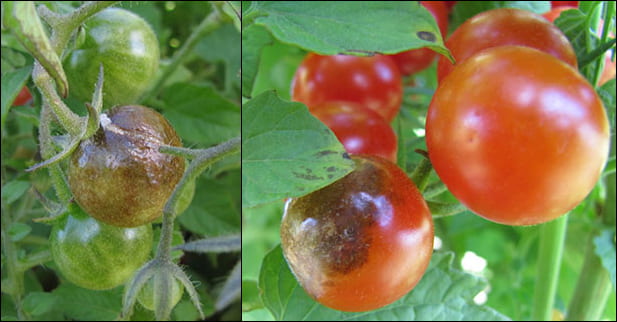
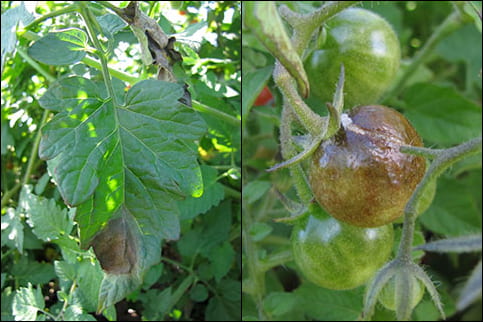
2013 trial
Following up on the 2012 trial, we conducted another replicated experiment at the Long Island Horticultural Research and Extension Center (LIHREC) in 2013 to evaluate additional varieties bred to be resistant to late blight or suspected to have resistance, as well as to confirm results obtained with some varieties tested in 2012. They were evaluated in terms of horticultural traits and ability to suppress late blight. Mt Fresh Plus was included as the industry standard for comparison. Most varieties evaluated produce standard red, round, slicer (beefsteak) type fruit. Plum, cherry, and campari (large cherry) types were also tested. All varieties tested are commercially available. One, Iron Lady, also has resistance to early blight and Septoria leaf spot, common foliar diseases occurring in the northeastern USA. It is from the Cornell Breeding Program.
Methods:
The experiment was conducted in a field dedicated to research on organically-produced crops since 2001. Organic fertilizer at 105 lb/A N was spread over rows to be planted, then incorporated. Three products were used each at 700 lb/A: Pro-Grow 5-3-4, Cheep Cheep 4-3-3, and 6-0-6 Cottonseed blend. Next drip tape was laid as the rows were covered with black plastic mulch. A living mulch was established by broadcasting a combination of annual ryegrass seed and clover seed with a hand-operated spreader between rows of plastic mulch, then lightly raking to incorporate. The living mulch plus weeds that grew were mowed routinely. Some weeds were removed by hand.
Tomato seedlings were transplanted by hand on 17 June into holes opened in the plastic mulch by a Waterwheel transplanter that also placed in the holes a starter fertilizer, Neptune’s Harvest Benefits of Fish (2-4-1 N-P-K). A completely randomized block design with four replications was used. Plots consisted of 10 plants in a single row with 24-in. plant spacing and 68-in. row spacing. A yellow cherry-type tomato plant (variety Sungold) separated plots within rows. Following standard procedure for fresh-market tomato production on Long Island, plants were staked and trellised as they grew using the Florida weave trellising system with 4-ft stakes placed between plants. No fungicides were applied.
Leaves were examined for symptoms of any foliar disease nine times from 31 July to 10 October. Late blight and other diseases observed were visually assessed by estimating the percentage of leaves in each plot with symptoms (incidence) and the severity of symptoms on these affected leaves. Canopy severity was calculated by multiplying these values. Area Under Disease Progress Curve (AUDPC) was calculated for late blight severity from 6 September through 10 October for all entries.
Ripe fruit were harvested on 21 and 30 August; 6, 13, 20, and 26 September; and 10 October. Yield was not measured for the three entries with cherry-type fruit. Fruit quality was evaluated by project staff and by public groups. Attributes assessed included appearance, taste, and overall quality rated on a 1-5 scale with 5 being excellent.
Results and Discussion
All entries with Ph-2 and Ph-3 major genes for resistance exhibited good suppression of late blight, confirming results obtained in a similar evaluation in 2012 (Table 3, below). This was most evident on 12 September. Iron Lady is the only variety with homozygous resistance (Ph-2 and Ph-3 genes from both parents); in contrast with expectation, it was not significantly less severely affected by late blight than the other three varieties with heterozygous resistance (one copy of Ph-2 and Ph-3)(Mountain Merit, Defiant PHR, and Mountain Magic). Canopy severity of late blight on 12 September was 72% for Mountain Fresh Plus, the susceptible variety included for comparison, and 1-3% for the four resistant varieties. Four entries with unknown resistance also effectively suppressed late blight: Matt’s Wild Cherry (0% severity on 12 September), Lemon Drop (6%), Jasper (9%), and Mr Stripey (12%). These were included in the evaluation because they exhibited resistance in other evaluations. Mountain Magic and Matt’s Wild Cherry were the most effective of all entries exhibiting resistance. They exhibited 93% and 98% control, respectively, over the entire assessment period (AUDPC values) compared to Mountain Fresh Plus. The entry with just Ph-3, Plum Regal (homozygous Ph-3), was effective compared to Mountain Fresh Plus only based on the 6 September assessment (25% versus 79% severity). Both New Yorker (Ph-1) and Legend OP (Ph-2) were as severely affected by late blight as the susceptible varieties, which suggests neither Ph-1 nor Ph-2 on their own are effective against US-23, which was the most common genotype of the pathogen in the northeast USA in 2012 and 2013, and thus most likely will dominate in 2014. Plum Regal and Legend OP provided some suppression in 2012 in an evaluation at this location; however, all plants in that experiment were sprayed five times with organic fungicides labeled for managing late blight.
Few symptoms were observed of powdery mildew and Septoria leaf spot. No significant differences were detected among the entries.
Most tomatoes evaluated produce red slicer-type fruit. The susceptible variety, Mountain Fresh Plus, produced the fewest marketable fruit (Table 4, below). Defiant yielded the most fruit among all varieties producing red slicer-type fruit. These varieties did not differ significantly from all of the others. Jasper, Matt’s Wild Cherry, and Mountain Magic were the varieties that rated highest for taste (average rating >4) and ‘would buy’ (>89%) by public groups participating in evaluations (Tables 5 and 6, below). Lemon Drop also was rated high. Among red slicer-types, Defiant and Mt Merit rated similarly high (3.7 for taste and 76-77% indicated they would buy these).
Another experiment was conducted at LIHREC in 2013 focused on evaluating new varieties being developed by Johnny’s Selected Seeds. Three experimentals with different fruit type (cherry, cocktail, and saladette types) exhibited good suppression of late blight and produced fruit of good quality. In this experiment, Jasper had the least symptoms, but did not differ significantly from these experimentals. Jasper rated highest for flavor (4.9 out of 5).
Organic growers on Long Island who grew late blight-resistant varieties in 2013 were satisfied with the varieties and control achieved, and appreciated the insurance provided by plant resistance to such a destructive disease that can occur unpredictably.
Table 3. Severity of late blight on tomato varieties evaluated at LIHREC in 2013.
|
Late blight canopy severity (%)z |
|||||||||||||
| Varietyy |
6 Sep |
12 Sep |
17 Sep |
2 Oct |
10 Oct |
AUDPCx |
|||||||
| Mountain Fresh Plus
(none; red slicer) |
78.9 |
a |
71.8 |
abc |
42.5 |
ab |
31.0 |
a |
21.8 |
ab |
1058.1 |
a | |
| West Virginia
(Ph-2; red slicer) |
97.3 |
a |
ND |
ND |
ND |
ND |
ND |
||||||
| New Yorker OP
(Ph-1; red slicer) |
96.0 |
a |
86.0 |
ab |
47.3 |
ab |
26.3 |
a |
11.9 |
abc |
1285.0 |
a | |
| Legend OP
(Ph-2; red slicer) |
55.5 |
ab |
42.5 |
bcd |
43.8 |
ab |
5.3 |
a |
4.4 |
bc |
728.3 |
abc | |
| Plum Regal
(Ph-3; plum) |
25.0 |
bc |
31.3 |
cd |
42.5 |
ab |
30.0 |
a |
29.3 |
a |
894.5 |
ab | |
| Mountain Merit
(Ph-2 + Ph-3; red slicer) |
17.8 |
bc |
3.1 |
d |
17.3 |
ab |
7.0 |
a |
5.0 |
bc |
220.9 |
bcd | |
| Defiant PHR
(Ph-2 + Ph-3; red slicer) |
8.9 |
bc |
2.3 |
d |
19.9 |
ab |
2.0 |
a |
3.8 |
bc |
137.2 |
cd | |
| Iron Lady
(Ph-2 + Ph-3; red slicer) |
4.9 |
bc |
1.6 |
d |
15.3 |
ab |
2.5 |
a |
7.0 |
bc |
125.2 |
cd | |
| Mountain Magic
(Ph-2 + Ph-3; campari) |
0.6 |
c |
1.3 |
d |
9.0 |
ab |
3.1 |
a |
1.5 |
c |
78.3 |
d | |
| Mr Stripey
(unknown; slicer) |
30.0 |
bc |
11.9 |
d |
5.1 |
ab |
3.0 |
a |
3.9 |
bc |
203.6 |
bcd | |
| Lemon Drop
(unknown; cherry) |
2.4 |
c |
6.0 |
d |
4.3 |
ab |
6.1 |
a |
2.0 |
c |
120.6 |
cd | |
| Jasper
(unknown; cherry) |
20.2 |
bc |
8.6 |
d |
0.0 |
b |
0.5 |
a |
1.8 |
bc |
99.3 |
cd | |
| Matt’s Wild Cherry
(unknown; cherry) |
0.3 |
c |
0.0 |
d |
1.9 |
b |
0.8 |
a |
3.8 |
bc |
26.4 |
d | |
| P-value (treatment) |
<0.0001 |
<0.0001 |
0.0054 |
0.0106 |
0.0002 |
<0.0001 |
|||||||
z Numbers in each column with a letter in common are not significantly different from each other (Tukey’s HSD, P=0.05). ND=not determined because too few leaves remained in plots to assess. Decline in severity over time for varieties severely affected at the first assessment reflects defoliation caused by late blight. Also, conditions late in the season were dry and thus not very favorable for late blight development.
y Entries are listed based on a combination of severity, resistance genes, and fruit type.
x AUDPC values were square root transformed before analysis. Table contains de-transformed values.
Table 4. Yield of tomato varieties grown at LIHREC, 2013.
|
Yield (# fruit/plant)z |
||||||||||||||||
|
Marketable |
Totaly |
|||||||||||||||
| Variety |
Seed sourcex |
3 Oct |
10 Oct |
Allw |
Size (oz) |
|
10 Oct |
Allw |
||||||||
| Mountain Fresh Plus |
BE |
0.2 |
b |
0.1 |
b |
2.1 |
c |
7.4 |
ab |
|
1.6 |
d |
34.2 |
bc | ||
| West Virginia |
CU |
0.1 |
b |
0.1 |
b |
13.4 |
c |
5.2 |
a-d |
|
0.8 |
d |
31.7 |
bc | ||
| New Yorker OP |
TT |
0.0 |
b |
0.0 |
b |
3.6 |
c |
6.6 |
abc |
|
1.0 |
d |
35.4 |
bc | ||
| Legend OP |
TGS |
0.5 |
b |
0.5 |
b |
10.7 |
c |
4.4 |
a-d |
|
4.9 |
cd |
43.5 |
bc | ||
| Plum Regal |
BE |
1.4 |
b |
6.2 |
b |
21.7 |
bc |
2.1 |
cd |
|
27.1 |
b |
79.5 |
b | ||
| Mountain Merit |
BE |
0.6 |
b |
2.8 |
b |
16.3 |
bc |
5.7 |
abc |
13.4 |
bcd |
46.0 |
bc | |||
| Defiant PHR |
JS |
2.2 |
ab |
3.0 |
b |
56.5 |
b |
3.0 |
bcd |
|
12.8 |
bcd |
86.8 |
b | ||
| Mountain Magic |
BE |
15.5 |
a |
22.2 |
a |
173.3 |
a |
0.8 |
d |
|
57.8 |
a |
254.0 |
a | ||
| Iron Lady |
HMS |
1.9 |
ab |
5.7 |
b |
29.4 |
bc |
3.7 |
a-d |
|
19.5 |
bc |
65.7 |
bc | ||
| Mr Stripey |
H |
0.0 |
b |
0.2 |
b |
15.3 |
c |
8.2 |
a |
|
5.4 |
cd |
17.1 |
c | ||
| Lemon Drop |
TT |
ND |
ND |
ND |
ND |
ND |
ND |
|||||||||
| Jasper |
JS |
ND |
ND |
ND |
ND |
ND |
ND |
|||||||||
| Matt’s Wild Cherry |
JS |
ND |
ND |
ND |
ND |
ND |
ND |
|||||||||
| P-value (treatment) |
0.0206 |
<0.0001 |
<0.0001 |
<0.0001 |
<0.0001 |
<0.0001 |
||||||||||
z Numbers in each column with a letter in common are not significantly different from each other (Tukey’s HSD, P=0.05). ND=not determined; all ripe fruit were not harvested from small-fruited varieties.
y ‘Total’ includes marketable and unmarketable fruit.
x BE= Bejo Seeds, HMS=High Mowing Seeds, JS=Johnny’s Selected Seeds, H=Harris, TGS=Tomato Growers Supply, and TT=Totally Tomato.
w ‘All’ includes the yield from all harvest dates which were: 21 Aug, 30 Aug, 6 Sep, 13 Sep, 20 Sep, 26 Sep, 3 Oct, and 10 Oct.
Table 5. Combined results of tomato evaluations performed by public groups in 2013. Results are organized by average Overall fruit rating with the best at the top.
| Variety |
Internal Appearance |
External Appearance |
Taste |
Overall Satisfaction |
Would Buy it (%) |
| Mountain Fresh Plus | 4.50 | 5.00 | 3.17 | 4.50 | 50 |
| Jasper | 4.64 | 4.59 | 4.35 | 4.46 | 91 |
| Matt’s Wild Cherry | 4.36 | 4.50 | 4.60 | 4.20 | 89 |
| Mountain Magic | 4.38 | 4.47 | 4.19 | 4.17 | 90 |
| Lemon Drop | 4.24 | 4.34 | 3.86 | 4.06 | 72 |
| Mountain Merit | 3.55 | 4.09 | 3.70 | 3.40 | 76 |
| Legend | 3.70 | 4.00 | 3.38 | 3.38 | 44 |
| Defiant PHR | 3.83 | 4.17 | 3.67 | 3.30 | 77 |
| West Virginia | 3.70 | 3.70 | 3.13 | 3.13 | 44 |
| Plum Regal | 3.85 | 3.97 | 2.99 | 3.07 | 43 |
| Iron Lady | 3.42 | 3.50 | 2.92 | 3.00 | 50 |
| New Yorker | 3.60 | 3.60 | 3.75 | 3.00 | 67 |
| Mr Stripey | 3.70 | 3.50 | 3.13 | 2.88 | 44 |
External fruit appearance, internal appearance, taste and overall quality ratings done on a 1 (poor) to 5 (excellent) scale. “Would Buy It” has percentage of evaluators who would purchase fruit of this variety.
Table 6. Tomato fruit evaluation conducted by a gardening group in 2013. Results are organized by average Overall fruit rating with the best at the top.
| Variety |
Internal Appearance |
External Appearance |
Taste |
Overall Satisfaction |
Would Buy it (%) |
|
| Mt. Merit |
4.50 |
4.08 |
4.55 |
4.40 |
83 |
|
| Jasper |
4.50 |
4.44 |
4.23 |
4.33 |
100 |
|
| Defiant |
3.83 |
4.27 |
4.50 |
4.09 |
50 |
|
| Saladette |
3.73 |
3.92 |
4.00 |
3.73 |
64 |
|
| Mt. Magic |
3.67 |
3.73 |
4.33 |
3.36 |
58 |
|
| Plum Regal |
3.38 |
3.50 |
3.23 |
3.00 |
25 |
|
| Iron Lady |
2.25 |
3.42 |
3.25 |
2.22 |
0 |
External fruit appearance, internal appearance, taste and overall quality ratings done on a 1 (poor) to 5 (excellent) scale. “Would Buy It” has percentage of evaluators who would purchase fruit of this variety.
Images
Following images are of plants in this evaluation on 20 September 2013. Variety’s gene(s) for resistance to late blight are after its name.
Prepared by
Originally prepared in 2012 and 2013 by Margaret Tuttle McGrath, Long Island Horticultural Research and Extension Center, and Sandra Menasha Cornell Cooperative Extension-Suffolk County. Updated March 2021 by Margaret Tuttle McGrath.
Funding for these projects provided by Agriculture and Food Research Initiative Competitive Grants Program Grant 2011-68004-30154 from the USDA National Institute of Food and Agriculture.



